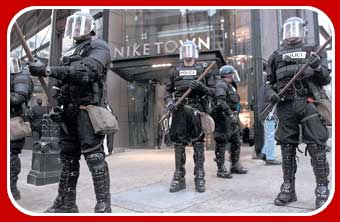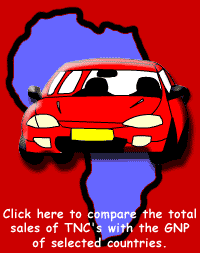| |
The ways in which goods
and information are moved between countries are becoming easier.
Information technology is driving these improvements by enabling
companies to move money and ideas instantly at the click of
a mouse. Consequently, people are becoming more interconnected
and interdependent, a trend known as 'globalisation'.
| Today,
there is 12 times more world trade in goods and money
than there was in 1945. |
 �
Chris Stowers/Panos Pictures.
�
Chris Stowers/Panos Pictures. |
The World Trade Organisation:
breaking down trade barriers
International trade has been going on for centuries, but the
removal of trade barriers that countries use to protect their
businesses, such as tariffs
and quotas
on imports, is likely to quicken the pace of globalisation.
Countries will be encouraged to produce the goods and services
that they can make more cheaply than their competitors; in
other words, 'do what you do best and trade for the rest'.
To ensure fair play in this more open trade system, the World
Trade Organisation (WTO) was set up in 1995. The WTO can impose
penalties on countries that break the rules. However, critics
argue that many poor countries do not have enough representatives
at the WTO. Consequently, WTO representatives of richer countries
are able to influence the rules so that trade barriers in
the developed world, such as the EU's Common
Agricultural Policy, continue to protect their businesses
and give them an advantage. Nevertheless, there are moves
to reform the WTO so that every country can benefit from the
process of globalisation.

� Popperfoto/Reuters
The
WTO meeting in Seattle, USA during November 1999 received
worldwide attention as people protested outside the buildings
of big companies and they brought the meeting to a halt. Representing
a variety of pressure groups, the protesters were questioning
the role of the WTO and the direction of globalisation.
Transnational
Companies � Friend or Foe?
Although trade rules are agreed between countries, it is companies
that do the trading. Many believe that the real winners of
a more open trade system will be the large companies that
already dominate world trade. By setting up factories in different
countries to manufacture or assemble components, companies
can produce goods more cheaply and efficiently. Today, these
'transnational'
companies (TNCs) control two thirds of world trade. With
more open trade, TNCs have greater freedom to shift location
to developing countries where wages are lower and they are
less restricted by environmental controls.

Globalisation
can mean that products are manufactured in more than one country...
drag your cursor over the bike to get an idea.
(adapted
from New Internationalist Nov 1997)
Competition between poorer
countries to attract foreign investment is fierce. To offer
the best deal to TNCs, wages are sometimes forced down so
low that human rights groups have found working conditions
in some factories that they describe as modern day slavery.
Also, jobs may involve merely fixing together imported parts
and materials, which do little to build local skills and expertise.
However, TNCs can help
developing countries by creating jobs and generating investment
that can be used to educate local people to develop homegrown
skills and expertise. Local businesses benefit too as factory
workers spend their earnings. South Korea is a country that
has gained from these knock-on effects. By manufacturing goods
cheaply, many Koreans now enjoy a standard of living similar
to Europeans thanks to the profits from exports. China is
now following suit. Fuelled by foreign investment, China is
now the world's biggest exporter of clothes, toys, shoes and
electronic goods, and average incomes in urban areas are ten
times greater than they were 20 years ago.
Different Trading
Opportunities
Selling goods and services in a more open world market should
bring more money into a country, but it depends what you are
selling, and whether you have the resources, infrastructure
and technology to take advantage of the new market conditions.
Today, the poorest 10% of the world's population take part
in less than 0.5% of the world's trade. Many lack the technology,
infrastructure and manufacturing base to compete with companies
in the developed world.
| Farmers
in the remote Peruvian Andes have been nicknamed, 'los
desenchufados', the unplugged ones, as they are unable
to access new technology. Consequently, they fall further
behind their richer competitors. |
 �Jeremy
Horner/Panos Pictures.
�Jeremy
Horner/Panos Pictures. |
Instead,
people rely on the sale of primary commodities even though their
world price compared to manufactured goods, or 'terms of trade,'
is now at its lowest for 150 years. To afford the same amount
of manufactured imports, poorer countries may have to produce
more primary commodities, which could use up scarce land and
resources in some countries. On the other hand, many African
and South American countries do have abundant natural resources
that could be traded. This could help people escape poverty
in the future.
The
Digital Divide:

Making Globalisation
work for the poor
The processes of globalisation are certainly complicated.
Whilst they bring new opportunities, they also present some
tough challenges ahead. With a more open market place, poor
communities in many countries could escape poverty as they
gain access to new markets to sell their goods and services.
Poorer countries will
need to invest in roads, ports and airports so people in remote
areas can benefit as well. Many poorer countries that do not
have enough money of their own will need investment from abroad.
To attract foreign investment, governments need peaceful conditions
and to prevent corruption. Poorer countries need to be fully
involved in any changes in world trade rules and to avoid
the possible drawbacks of globalisation. By managing globalisation
in this way, it could help to bring lasting benefits to the
fifth of the world's population that currently live in extreme
poverty.
|
|





